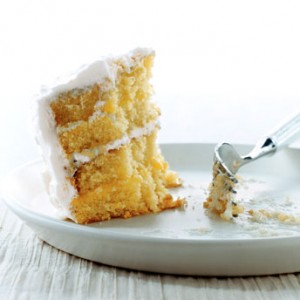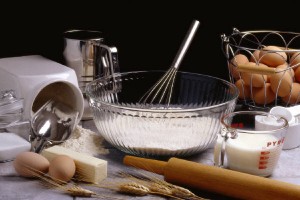The Science of Baking Cakes

It is said that baking is not only an art but more importantly it is a science. First let’s take a look at the science of baking a cake for each main ingredient in a recipe serves an important purpose. The basic carrot cake recipes are all pretty much the same, 2 cups sugar, 2 cups flour, 1 1/2 cups oil, 4 eggs and 3 cups carrots.
- Every carrot cake recipe I found called for 2 to 2 1/2 cups of flour. Flour is the primary structure builder in most cakes. The gluten in the flour reacts with the leavening agent (baking soda and baking powder and oil) during baking to make the cake rise.
- The second ingredient is sugar. The first rule in baking states that the sugar should weigh slightly more or equal to the amount of flour used. This is because the sugar is needed to tenderize the gluten in the flour and acts as a sweetener and preservative to keep the cake moist for several days. About 50 percent of the sugar may be replaced with a liquid substitute; although, when replacing granular sugar for the liquid form, the liquid content of the recipe must be reduced slightly by a couple of tablespoons to a ¼ cup to compensate. The combined weight of the liquid (eggs, fats, milk water, fruits, vegetables, ect) should equal or exceed the weight of the sugar.
- The third ingredient is oil. Oil like sugar acts as a tenderizing agent to keep the cake from drying out while baking. Oil is also used in correlation with baking soda and powder as a leavening agent. When the oil is mixed into the batter it helps to incorporate air into the cake giving it volume.
- The fourth main ingredient is eggs. Eggs react with the flour and oil in providing structure and strength. Because of the tenderizing properties of oil the proteins in eggs are necessary to give the cake support. Therefore, the weight of the eggs should equal or exceed the weight of the oil.
Other things to consider:
It is necessary to consider the amount of fat, eggs and liquid used in a recipe. The liquid in the cake (milk, water, milk, eggs, vegetable, fruit, vanilla) serves to develop the gluten, dissolves the sugar, ignites the baking powder and regulates the temperature of the batter while in the oven. Liquids should always equal or exceed the weight of the sugar. If not enough liquid is used to dissolve the sugar, the cake will collapse in the center. If there is too much flour there will not be enough liquid to dissolve the sugar. The amount of liquid is partially controlled by the type of fat used as oils, margarine and shortening vary in the amount of water they contain.
In our carrot cake recipe we need 50-60 percent as much oil as flour. The weight of the eggs should equal or slightly exceed the weight of the oil. The combined weight of the eggs plus the liquid (fats, milk water, fruits, vegetables, ect) should equal or exceed the weight of the sugar. The weight of the sugar should equal the weight of the flour.
On to Substitutions:
I have just given you the rules based on the science of baking a cake. Now let’s discuss the exceptions to the rules. Theoretically the sugar and oil can be reduced slightly without a replacement in most recipes. Substitutions are not ideal especially when baking delicate foods such as pastries. Quick breads like banana bread or carrot cake offer a little more room for error.

Put science to the test with this cake science project. Learn about chemical reactions by baking 4 small cakes leaving one important ingredient out of 3 of them. The ingredients are only for 1 cake, so you’ll need to measure and mix 4 times.
What you’ll need:
• A small soup or cereal bowl
• Several layers of aluminum foil
• A pie pan
• Cooking oil to grease the “cake pans”
• Measuring spoons
• A cup or small bowl for the egg
• A small mixing bowl
• Your science journal
Ingredients:
• 6 tablespoons flour
• 3 tablespoons sugar
• Pinch of salt
• 2 or 3 pinches baking powder
• 2 tablespoons milk
• 2 tablespoons cooking oil
• 1/4 teaspoon vanilla
• Part of an egg
(Break egg into a cup, beat until mixed.
Use 1/3 of it. Save the rest for 2 of the other cakes.)
What to do:
1. Wrap several layers of aluminum foil around the outside of a cereal or soup bowl to form a mold.
2. Remove your foil “pan” and put it in a pie pan for support.
3. Oil the “inside” of your foil pan with cooking oil so the cake doesn’t stick.
4. Turn the oven on to 350 degrees.
5. Mix all of the dry ingredients together. Add the wet ones (only use 1/3 of the egg). Stir until smooth and all the same color.
6. Pour batter into the “pan.”
7. Bake for 15 minutes.
8. Bake 3 more cakes:
Leave the oil out of one.
Leave the egg out of another.
Leave the baking powder out of the third.
Cut each cake in half and look at the insides.
Do they look different?
Do they taste different?
9. Write about, or draw pictures of, what you see and taste.
Heat helps some chemical reactions to occur as the cake bakes:
It helps baking powder produce tiny bubbles of gas making the cake light and fluffy (this is called leavening).
It causes protein from the egg to change and make the cake firm.
Oil keeps the heat from drying out the cake.
You must be logged in to post a comment.